- Recent Articles
- Most Citedi
- Most Viewedi
- Artigos Futuros
-
02-26-2024
Nurse Navigator of Cancer Patients: contributions to the discussion on the national stage
Revista Brasileira de Enfermagem. 2024;77(2):e770201
Views0

This is an Open Access article distributed under the terms of the Creative Commons Attribution License, which permits unrestricted use, distribution, and reproduction in any medium, provided the original work is properly cited. Abstract
Nurse Navigator of Cancer Patients: contributions to the discussion on the national stage
Revista Brasileira de Enfermagem. 2024;77(2):e770201
DOI 10.1590/0034-7167.2024770201
Views0The professional practice of patient navigation is incipient in Brazil and, therefore, a broad discussion with various sectors of society is essential, which is the main purpose of this editorial. Shall we start with the story. Patient navigation was defined in 1989 as a community-based service delivery intervention aimed at appropriately promoting access to diagnosis […]See more

This is an Open Access article distributed under the terms of the Creative Commons Attribution License, which permits unrestricted use, distribution, and reproduction in any medium, provided the original work is properly cited. -
REVIEW02-26-2024
Evidence of intrauterine device insertion by nurses in Primary Health Care: an integrative review
- Lays Souza de Oliveira
 ,
, - Patrícia Madalena Vieira Hermida
 ,
, - Elizimara Ferreira Siqueira
 ,
, - Juliana Cipriano Braga Silva de Arma
 ,
, - Larissa Scheeren Thomas
 , [ … ],
, [ … ], - Indiara Sartori Dalmolin

Views0

This is an Open Access article distributed under the terms of the Creative Commons Attribution License, which permits unrestricted use, distribution, and reproduction in any medium, provided the original work is properly cited. Abstract
REVIEWEvidence of intrauterine device insertion by nurses in Primary Health Care: an integrative review
Revista Brasileira de Enfermagem. 2024;77(1):e20230134
DOI 10.1590/0034-7167-2023-0134
- Lays Souza de Oliveira
 ,
, - Patrícia Madalena Vieira Hermida
 ,
, - Elizimara Ferreira Siqueira
 ,
, - Juliana Cipriano Braga Silva de Arma
 ,
, - Larissa Scheeren Thomas
 ,
, - Indiara Sartori Dalmolin

Views0See moreABSTRACT
Objectives:
to synthesize and analyze evidence on intrauterine device insertion by nurses in Primary Health Care.
Methods:
an integrative review, carried out in the BDENF, CINAHL, LILACS, SciELO, Scopus, PubMed and Web of Science databases in June 2022, delimiting the period from 1960 to 2022.
Results:
141 articles were identified in the initial search, and 10 studies made up the final sample. Four (40%) were developed in the United States and one (10%) in Brazil, with publications from 1979 to 2021. The findings were grouped into three categories: Nurse training to insert an intrauterine device; Nurses’ competency to insert an intrauterine device; and Women’s access to intrauterine devices.
Conclusions:
nurse theoretical and practical training is a prominent element, consolidated in the favorable outcomes of insertions performed by nurses and satisfaction among women, a practice that has expanded access to the contraceptive method in Primary Health Care.


This is an Open Access article distributed under the terms of the Creative Commons Attribution License, which permits unrestricted use, distribution, and reproduction in any medium, provided the original work is properly cited. 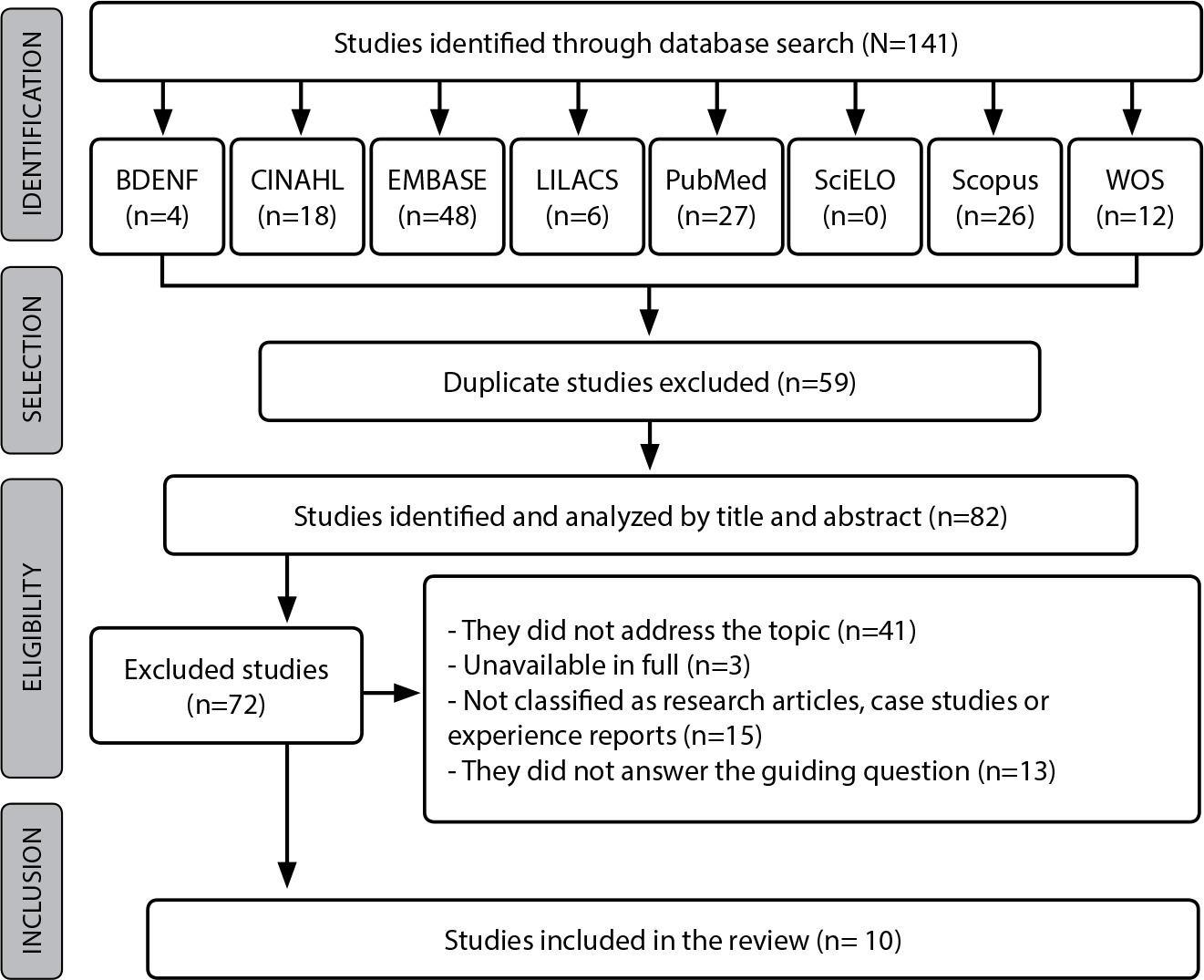
- Lays Souza de Oliveira
-
ORIGINAL ARTICLE02-26-2024
Artificial intelligence to predict bed bath time in Intensive Care Units
Revista Brasileira de Enfermagem. 2024;77(1):e20230201
Views0

This is an Open Access article distributed under the terms of the Creative Commons Attribution License, which permits unrestricted use, distribution, and reproduction in any medium, provided the original work is properly cited. Abstract
ORIGINAL ARTICLEArtificial intelligence to predict bed bath time in Intensive Care Units
Revista Brasileira de Enfermagem. 2024;77(1):e20230201
DOI 10.1590/0034-7167-2023-0201
Views0See moreABSTRACT
Objectives:
to assess the predictive performance of different artificial intelligence algorithms to estimate bed bath execution time in critically ill patients.
Methods:
a methodological study, which used artificial intelligence algorithms to predict bed bath time in critically ill patients. The results of multiple regression models, multilayer perceptron neural networks and radial basis function, decision tree and random forest were analyzed.
Results:
among the models assessed, the neural network model with a radial basis function, containing 13 neurons in the hidden layer, presented the best predictive performance to estimate the bed bath execution time. In data validation, the squared correlation between the predicted values and the original values was 62.3%.
Conclusions:
the neural network model with radial basis function showed better predictive performance to estimate bed bath execution time in critically ill patients.


This is an Open Access article distributed under the terms of the Creative Commons Attribution License, which permits unrestricted use, distribution, and reproduction in any medium, provided the original work is properly cited. -
ORIGINAL ARTICLE02-26-2024
Technological prospecting of patents related to monitoring accidents due to falls in hospitals
Revista Brasileira de Enfermagem. 2024;77(1):e20230084
Abstract
ORIGINAL ARTICLETechnological prospecting of patents related to monitoring accidents due to falls in hospitals
Revista Brasileira de Enfermagem. 2024;77(1):e20230084
DOI 10.1590/0034-7167-2023-0084
Views0See moreABSTRACT
Objectives:
to map the production of technologies aimed at monitoring falls in a hospital environment protected by registered patents.
Methods:
a technological prospecting of international patents, with a quantitative approach, with search carried out between February and March 2022 in the Derwent Innovations Index database with descriptors fall, hospital, monitoring.
Results:
212 patents were found, with the majority filed and published since 2010, by Tran B (9) and Cerner Innovation Inc (9), focused on health technology. Universities were responsible for 13% of deposits. There was a predominance of records from the United States (43.4%), China (21.7%) and Japan (12.3%), in addition to technological strategies classified as devices for the environment (80.7%) and for preventing falls (66.5%) as well as trend towards resources with multiple functionalities in the same technology.
Conclusions:
the plurality of functions in the same device reflects the search for optimizing resources and the concern with comprehensive care.


This is an Open Access article distributed under the terms of the Creative Commons Attribution License, which permits unrestricted use, distribution, and reproduction in any medium, provided the original work is properly cited. 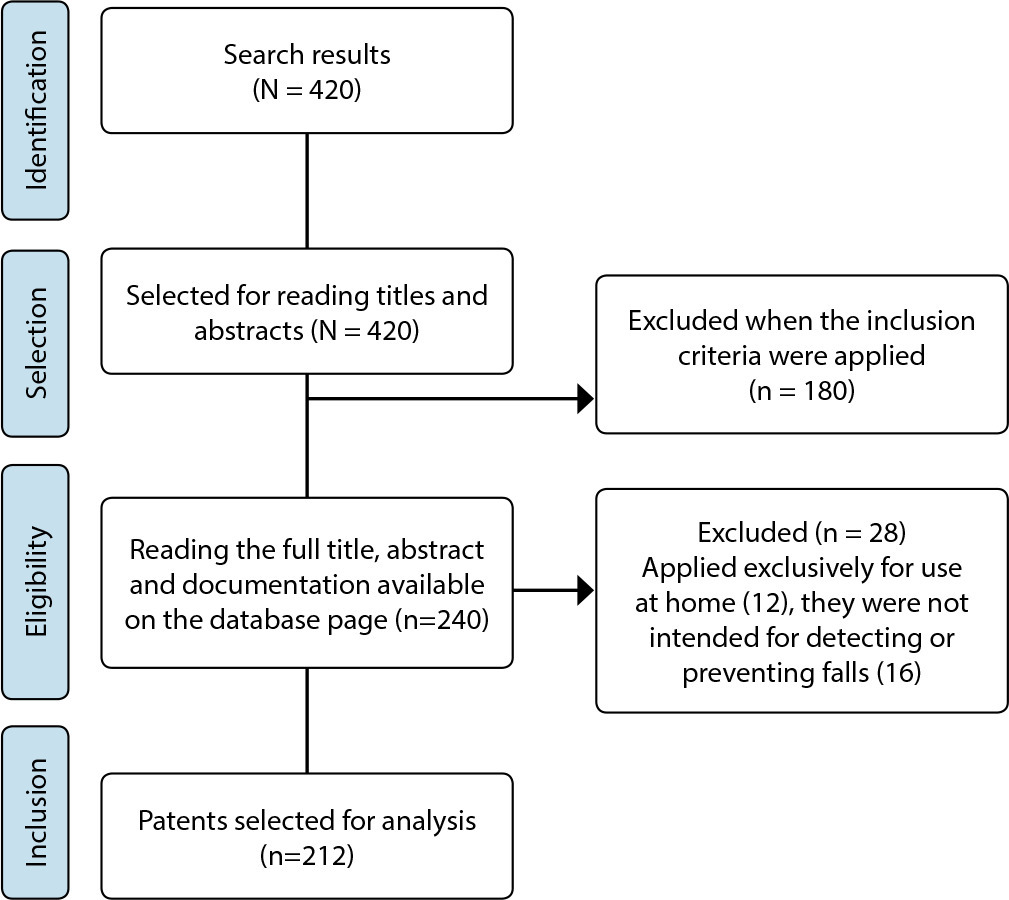
-
ERRATUM02-26-2024
ERRATUM
Revista Brasileira de Enfermagem. 2024;77(1):e20230045
Abstract
ERRATUMERRATUM
Revista Brasileira de Enfermagem. 2024;77(1):e20230045
DOI 10.1590/0034-7167.20247701e04
Views2In the article “Coping strategies for chronically ill children and adolescents facing the COVID-19 pandemic”, with DOI number: , published in Revista Brasileira de Enfermagem, 2023;76(Suppl 2):e20230045, in the author:Where it read:[…]See more

This is an Open Access article distributed under the terms of the Creative Commons Attribution License, which permits unrestricted use, distribution, and reproduction in any medium, provided the original work is properly cited. -
ERRATUM02-26-2024
ERRATUM
Revista Brasileira de Enfermagem. 2024;77(1):e2024n1e02
Abstract
ERRATUMERRATUM
Revista Brasileira de Enfermagem. 2024;77(1):e2024n1e02
DOI 10.1590/0034-7167.20247701e02
Views2In the article “Active teaching model to promote critical thinking”, with DOI number: , published in Revista Brasileira de Enfermagem, 2019;72(1):293-8, on page 297:Include before REFERENCES:[…]See more

This is an Open Access article distributed under the terms of the Creative Commons Attribution License, which permits unrestricted use, distribution, and reproduction in any medium, provided the original work is properly cited. -
ERRATUM02-26-2024
ERRATUM
Revista Brasileira de Enfermagem. 2024;77(1):e20160061
Abstract
ERRATUMERRATUM
Revista Brasileira de Enfermagem. 2024;77(1):e20160061
DOI 10.1590/0034-7167.20247701e03
Views2In the article “Nurses in the labor market: professional insertion, competencies and skills”, with DOI number: , published in Revista Brasileira de Enfermagem, 2017;70(6):1220-6, on page 1225:Include before REFERENCES:[…]See more

This is an Open Access article distributed under the terms of the Creative Commons Attribution License, which permits unrestricted use, distribution, and reproduction in any medium, provided the original work is properly cited. -
REVIEW02-26-2024
Practice of immersion in hot water to relieve pain in neonatology: an integrative review
- Danton Matheus de Souza
 ,
, - Maria Eduarda Pires Yamamoto
 ,
, - Joese Aparecida Carvalho
 ,
, - Vanderlei Amadeu da Rocha
 ,
, - Vanessa Dias Fogaça
 , [ … ],
, [ … ], - Lisabelle Mariano Rossato

Views1

This is an Open Access article distributed under the terms of the Creative Commons Attribution License, which permits unrestricted use, distribution, and reproduction in any medium, provided the original work is properly cited. Abstract
REVIEWPractice of immersion in hot water to relieve pain in neonatology: an integrative review
Revista Brasileira de Enfermagem. 2024;77(1):e20230260
DOI 10.1590/0034-7167-2023-0260
- Danton Matheus de Souza
 ,
, - Maria Eduarda Pires Yamamoto
 ,
, - Joese Aparecida Carvalho
 ,
, - Vanderlei Amadeu da Rocha
 ,
, - Vanessa Dias Fogaça
 ,
, - Lisabelle Mariano Rossato

Views1See moreABSTRACT
Objectives:
to identify immersion use in hot water to relieve pain in newborns.
Methods:
an integrative literature review, carried out in the PubMed, VHL, EMBASE, Scopus, CINAHL, Cochrane and SciELO databases, with investigations in English, Spanish, French or Portuguese, published between 2002 and 2022. The Health Sciences Descriptors (DeCS) and Medical Subject Headings (MeSH) were used to answer the following question: what are the uses of hot water immersion in relieving pain in newborns?
Results:
nine studies were included, mainly Brazilian, experimental, with a predominance of strong and moderate levels of evidence. Hydrotherapy and bath use (immersion and bandaging) was observed, promising interventions in reducing pain scores, assessed using scales, physiological and endocrine parameters.
Conclusions:
hot water proved to be a promising non-pharmacological intervention in relieving pain in infants in different contexts.


This is an Open Access article distributed under the terms of the Creative Commons Attribution License, which permits unrestricted use, distribution, and reproduction in any medium, provided the original work is properly cited. 
- Danton Matheus de Souza
-
EXPERIENCE REPORT01-01-2018
Clinical and epidemiological teaching of dengue through simulated practice
- João Henrique de Morais Ribeiro,
- Eloá Otrenti,
- Renata Ferreira Takahashi,
- Lúcia Yasuko Izumi Nichiata,
- Maria Clara Padoveze, [ … ],
- Suely Itsuko Ciosak
Views2

This is an Open Access article distributed under the terms of the Creative Commons Attribution License, which permits unrestricted use, distribution, and reproduction in any medium, provided the original work is properly cited. Abstract
EXPERIENCE REPORTClinical and epidemiological teaching of dengue through simulated practice
Revista Brasileira de Enfermagem. 2018;71(2):451-456
DOI 10.1590/0034-7167-2016-0503
- João Henrique de Morais Ribeiro,
- Eloá Otrenti,
- Renata Ferreira Takahashi,
- Lúcia Yasuko Izumi Nichiata,
- Maria Clara Padoveze,
- Érica Gomes Pereira,
- Sebastião Silveira Nunes Júnior,
- Anna Luiza de Fátima Pinho Lins Gryschek,
- Suely Itsuko Ciosak
Views2See moreABSTRACT
Objective:
to describe the experience of clinical teaching on dengue and the practice of epidemiological surveillance using problematization methodology.
Method:
report of experience on educational activity with undergraduate nursing students, held in March 2016, at a public university in the city of São Paulo, conceived in four stages: dialogic lecture, active search of Aedes aegypti, case study and simulation of nursing consultation to individuals with dengue.
Results:
The activity allowed to retrieve previous knowledge about the disease, respond to exercises that addressed different clinical situations and epidemiological surveillance, including in situ evaluation of possible mosquito outbreaks, and discuss the need to expand prevention and health of the individual and the community, the impact of the media in the dissemination of cases and the coping difficulties experienced in the different levels of attention.
Conclusion:
the methodology adopted enabled qualified training of students to cope with dengue.


This is an Open Access article distributed under the terms of the Creative Commons Attribution License, which permits unrestricted use, distribution, and reproduction in any medium, provided the original work is properly cited. 
-
ORIGINAL ARTICLE07-18-2022
Beliefs, knowledge, actions of nursing techniques in breastfeeding in pain management in immunization
- Isadora Trinquinato Rosa
 ,
, - Lisabelle Mariano Rossato
 ,
, - Danila Maria Batista Guedes
 ,
, - Vanessa Dias Fogaça
 ,
, - Flávia Domingues
 , [ … ],
, [ … ], - Lucía Silva

Views1

This is an Open Access article distributed under the terms of the Creative Commons Attribution License, which permits unrestricted use, distribution, and reproduction in any medium, provided the original work is properly cited. Abstract
ORIGINAL ARTICLEBeliefs, knowledge, actions of nursing techniques in breastfeeding in pain management in immunization
Revista Brasileira de Enfermagem. 2022;75(6):e20210546
DOI 10.1590/0034-7167-2021-0546
- Isadora Trinquinato Rosa
 ,
, - Lisabelle Mariano Rossato
 ,
, - Danila Maria Batista Guedes
 ,
, - Vanessa Dias Fogaça
 ,
, - Flávia Domingues
 ,
, - Lucía Silva

Views1See moreABSTRACT
Objective:
Understand the beliefs, knowledge, and actions of nursing technicians on breastfeeding as a form of non-pharmacological intervention to relieve pain in newborns and infants during immunization.
Methods:
Qualitative study carried out through semi-structured interviews with nine nursing technicians from three Basic Health Units in a city in the state of São Paulo. The theoretical approach of the Belief Model and the methodological framework of Thematic Analysis supported this study.
Results:
Three themes originated: Beliefs, Knowledge, and Actions of nursing technicians.
Final considerations:
Despite knowledge about the benefits of breastfeeding as the most effective method for relieving pain in newborns and infants during vaccination, their restrictive beliefs overrode the evidence, leading them to act in ways that discourage or prevent the mother from breastfeed during vaccination. Formal training is recommended to align with current evidence-based practices.


This is an Open Access article distributed under the terms of the Creative Commons Attribution License, which permits unrestricted use, distribution, and reproduction in any medium, provided the original work is properly cited. - Isadora Trinquinato Rosa
-
REVIEW12-08-2023
Educational technologies for accident prevention due to falls in childhood: a scoping review
- Abiúde Nadabe e Silva
 ,
, - Aline Costa de Oliveira
 ,
, - Jefferson Abraão Caetano Lira
 ,
, - Ana Roberta Vilarouca da Silva
 ,
, - Lídya Tolstenko Nogueira

Views2

This is an Open Access article distributed under the terms of the Creative Commons Attribution License, which permits unrestricted use, distribution, and reproduction in any medium, provided the original work is properly cited. Abstract
REVIEWEducational technologies for accident prevention due to falls in childhood: a scoping review
Revista Brasileira de Enfermagem. 2023;76:e20220807
DOI 10.1590/0034-7167-2022-0807
- Abiúde Nadabe e Silva
 ,
, - Aline Costa de Oliveira
 ,
, - Jefferson Abraão Caetano Lira
 ,
, - Ana Roberta Vilarouca da Silva
 ,
, - Lídya Tolstenko Nogueira

Views2See moreABSTRACT
Objectives:
to map evidence on educational technology use for accident prevention due to falls in childhood.
Methods:
a scoping review, carried out in October and November 2022, in the MEDLINE, Web of Science, BDENF and CINAHL databases and LILACS bibliographic index. There was no delimitation of language or time. Data were extracted and analyzed descriptively by two independent researchers. The research protocol was registered in the Open Science Framework.
Results:
twenty-six studies were selected. Booklets, pamphlets and leaflets were the most used technologies, presenting health services as the most frequent environment to develop research on fall prevention. The technologies developed were important outcomes: increased knowledge of children, family members, caregivers, health and education professionals.
Conclusions:
educational technology use makes it possible to increase knowledge, adopt safe practices and reduce falls.


This is an Open Access article distributed under the terms of the Creative Commons Attribution License, which permits unrestricted use, distribution, and reproduction in any medium, provided the original work is properly cited. 
- Abiúde Nadabe e Silva
-
REVIEW03-15-2024
Resources for health literacy among caregivers of prematurely born children: a scoping review
- Ana Clara Gomes Andrade
 ,
, - Giovanna Barbosa Mendes
 ,
, - Mariana Fuentes Mendoza Rodrigues Soares
 ,
, - Suelen Rosa de Oliveira
 ,
, - Luciano Marques dos Santos
 , [ … ],
, [ … ], - Elysângela Dittz Duarte

Abstract
REVIEWResources for health literacy among caregivers of prematurely born children: a scoping review
Revista Brasileira de Enfermagem. 2024;77(1):e20230062
DOI 10.1590/0034-7167-2023-0062
- Ana Clara Gomes Andrade
 ,
, - Giovanna Barbosa Mendes
 ,
, - Mariana Fuentes Mendoza Rodrigues Soares
 ,
, - Suelen Rosa de Oliveira
 ,
, - Luciano Marques dos Santos
 ,
, - Elysângela Dittz Duarte

Views1See moreABSTRACT
Objectives:
to map the available evidence on resources used to promote health literacy among caregivers of prematurely born children during outpatient follow-up.
Methods:
the Joanna Briggs Institute’s scope review protocol was utilized. The search encompassed six databases, incorporating studies from 2012 to 2022.
Results:
the three included publications revealed that the resources employed are: mobile applications, phone calls, individual counseling, videos, educational pamphlets, and group discussions. Implementing an education protocol during the transition home enhances scientifically grounded health promotion rates.
Conclusions:
there is limited literature addressing the health literacy of these caregivers. The nursing team plays a crucial role in health education and in developing resources applicable to these families.


This is an Open Access article distributed under the terms of the Creative Commons Attribution License, which permits unrestricted use, distribution, and reproduction in any medium, provided the original work is properly cited. 
- Ana Clara Gomes Andrade
-
ORIGINAL ARTICLE01-13-2024
Social representations of oncologic surgery for patients with cancer
- Rômulo Frutuoso Antunes
 ,
, - Rachel Verdan Dib
 ,
, - Raquel de Souza Ramos
 ,
, - Antonio Marcos Tosoli Gomes
 ,
, - Manassés Moura dos Santos
 , [ … ],
, [ … ], - Karen Paula Damasceno dos Santos Souza

Abstract
ORIGINAL ARTICLESocial representations of oncologic surgery for patients with cancer
Revista Brasileira de Enfermagem. 2024;77(6):e20230273
DOI 10.1590/0034-7167-2023-0273
- Rômulo Frutuoso Antunes
 ,
, - Rachel Verdan Dib
 ,
, - Raquel de Souza Ramos
 ,
, - Antonio Marcos Tosoli Gomes
 ,
, - Manassés Moura dos Santos
 ,
, - Margarida Maria Rocha Bernardes
 ,
, - Carolina Cristina Scrivano dos Santos
 ,
, - Karen Paula Damasceno dos Santos Souza

Views2See moreABSTRACT
Objectives:
to analyze the social representations of patients with cancer regarding oncologic surgery.
Methods:
a qualitative study based on Social Representation Theory was conducted with 126 participants between October 2021 and May 2022 in a public hospital in Rio de Janeiro. A characterization questionnaire, free evocations of the inducing term “surgery”, and semi-structured interviews with 60 participants were applied. Data were analyzed using Microsoft Excel® and IRaMuTeQ.
Results:
the central core of the representation is composed of fear, cure, hope, and removing the disease. The analysis of interviews resulted in six classes that highlight the social changes caused by treatment as well as the need for a support network to cope with the surgical process.
Final Considerations:
the representations reflect fear and hope towards the procedure and the desire to remove the disease, thus translating the cure through surgery.


This is an Open Access article distributed under the terms of the Creative Commons Attribution License, which permits unrestricted use, distribution, and reproduction in any medium, provided the original work is properly cited. 
- Rômulo Frutuoso Antunes
-
ORIGINAL ARTICLE01-13-2024
Nurses’ perspectives on the use of telemonitoring in the management of people with diabetes and hypertension
- Camila Wohlenberg Camparoto
 ,
, - Maria do Carmo Fernandez Lourenço Haddad
 ,
, - Elen Ferraz Teston
 ,
, - Pamela dos Reis
 ,
, - Sonia Silva Marcon

Abstract
ORIGINAL ARTICLENurses’ perspectives on the use of telemonitoring in the management of people with diabetes and hypertension
Revista Brasileira de Enfermagem. 2024;77(6):e20230481
DOI 10.1590/0034-7167-2023-0481
- Camila Wohlenberg Camparoto
 ,
, - Maria do Carmo Fernandez Lourenço Haddad
 ,
, - Elen Ferraz Teston
 ,
, - Pamela dos Reis
 ,
, - Sonia Silva Marcon

Views3See moreABSTRACT
Objectives:
to understand the perspective of nurses on the use of telemonitoring in the management of people with type 2 diabetes mellitus and arterial hypertension in primary care.
Methods:
this qualitative research involved sixteen nurses from eight municipalities in Paraná. Data were collected between November 2022 and January 2023 through inperson or remote interviews, which were audio-recorded and subjected to content analysis.
Results:
according to the nurses, telemonitoring enhances users’ knowledge about these conditions, communication and connection with the team, and productivity. However, the lack of electronic resources and equipment, high staff turnover, low user adherence, and the limited availability of professional time present significant challenges.
Final Considerations:
the effective implementation and operation of telemonitoring in the management of people with diabetes and hypertension involve both potential benefits and barriers. It is essential to have the availability of human and technological resources, managerial support, and the commitment of professionals and users.


This is an Open Access article distributed under the terms of the Creative Commons Attribution License, which permits unrestricted use, distribution, and reproduction in any medium, provided the original work is properly cited. - Camila Wohlenberg Camparoto
-
ERRATUM01-13-2024
ERRATUM
Revista Brasileira de Enfermagem. 2024;77(6):e2024n6e08
Abstract
ERRATUMERRATUM
Revista Brasileira de Enfermagem. 2024;77(6):e2024n6e08
DOI 10.1590/0034-7167.20247706e08
Views2In the article “Brazilian nursing specific situation, middle and micro-range theories: a bibliometric study”, with DOI number: , published in Revista Brasileira de Enfermagem, 2024;77(4):e20230520, Chart 1:Where it read:[…]See more

This is an Open Access article distributed under the terms of the Creative Commons Attribution License, which permits unrestricted use, distribution, and reproduction in any medium, provided the original work is properly cited. -
ORIGINAL ARTICLE09-29-2022
Palliative care production for health professionals in the context of home care
Revista Brasileira de Enfermagem. 2022;75(1):e20210030
Views1

This is an Open Access article distributed under the terms of the Creative Commons Attribution License, which permits unrestricted use, distribution, and reproduction in any medium, provided the original work is properly cited. Abstract
ORIGINAL ARTICLEPalliative care production for health professionals in the context of home care
Revista Brasileira de Enfermagem. 2022;75(1):e20210030
DOI 10.1590/0034-7167-2021-0030
Views1See moreABSTRACT
Objectives:
to analyze palliative care production developed by health professionals to home care patients.
Methods:
this is an exploratory study, with a qualitative approach, using the transpersonal care theoretical framework. Thirteen interviews were conducted with health professionals and 18 observations were conducted on different cases. Content analysis was performed using MAXQDA©.
Results:
actions performed: maintenance and follow-up measures to people eligible for palliative care, in acts of dialogue and “listening” to caregivers and users, conducting guidelines for the care and self-care process, performing technical procedures, delivery of materials, referrals and medical prescriptions to users.
Final Considerations:
it is perceived the need for advances in the implementation of government policies in Brazil that insert palliative care into the Health Care Network through educational, managerial and care actions that ensure human dignity, thus allowing the development of these and other palliative care interventions.


This is an Open Access article distributed under the terms of the Creative Commons Attribution License, which permits unrestricted use, distribution, and reproduction in any medium, provided the original work is properly cited.
-
ORIGINAL ARTICLE12-05-2019
Occurrence of violence in the elderly and its associated factors
- Paulo Henrique Silva Maia
 ,
, - Efigênia Ferreira e Ferreira
 ,
, - Elza Machado de Melo
 ,
, - Andréa Maria Duarte Vargas

Views0

This is an Open Access article distributed under the terms of the Creative Commons Attribution License, which permits unrestricted use, distribution, and reproduction in any medium, provided the original work is properly cited. Abstract
ORIGINAL ARTICLEOccurrence of violence in the elderly and its associated factors
Revista Brasileira de Enfermagem. 2019;72:64-70
DOI 10.1590/0034-7167-2018-0014
- Paulo Henrique Silva Maia
 ,
, - Efigênia Ferreira e Ferreira
 ,
, - Elza Machado de Melo
 ,
, - Andréa Maria Duarte Vargas

Views0See moreABSTRACT
Objective:
to analyze the occurrence of violence in the elderly and its associated factors in the city of Betim, Minas Gerais.
Method:
cross-sectional study constituted by a population survey conducted through structured interviews. The sample was stratified by clusters and included 178 elderly people at the end. Data were analyzed by the chi-square test and was performed a Correspondence Analysis.
Results:
The most prevalent forms of violence were: lack of access to social rights (31%), verbal violence (22%), moral/psychological (19%), lack of care (16%), physical violence (6%), sexual (3%) and discrimination (3%). Women suffered more abuse than men and violence had greater association with the degree of depressive symptoms.
Conclusion:
our research has direct implication for the sectors interested in coping with violence in the elderly, especially for nurses, because it shows violence is part of a cycle with characteristic associated factors that conforms a model nested mainly in the family relationship.


This is an Open Access article distributed under the terms of the Creative Commons Attribution License, which permits unrestricted use, distribution, and reproduction in any medium, provided the original work is properly cited. 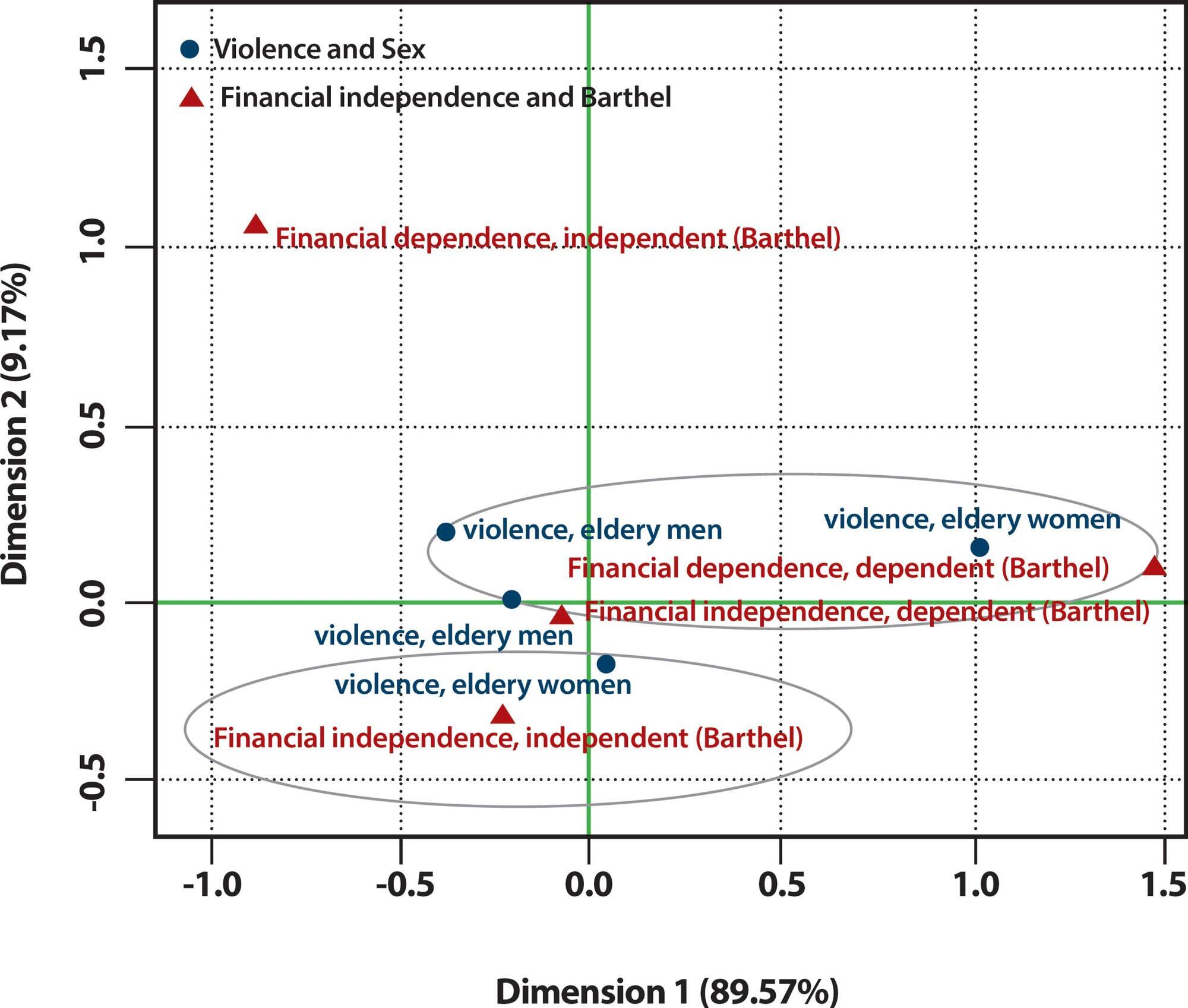
- Paulo Henrique Silva Maia
-
09-16-2019
Socioeconomic factors related to leprosy: an integrative literature review
- Heloisy Alves de Medeiros Leano
 ,
, - Kleane Maria da Fonseca Azevedo Araújo
 ,
, - Isabela de Caux Bueno
 ,
, - Eyleen Nabyla Alvarenga Niitsuma
 ,
, - Francisco Carlos Félix Lana

Views0

This is an Open Access article distributed under the terms of the Creative Commons Attribution License, which permits unrestricted use, distribution, and reproduction in any medium, provided the original work is properly cited. Abstract
Socioeconomic factors related to leprosy: an integrative literature review
Revista Brasileira de Enfermagem. 2019;72(5):1405-1415
DOI 10.1590/0034-7167-2017-0651
- Heloisy Alves de Medeiros Leano
 ,
, - Kleane Maria da Fonseca Azevedo Araújo
 ,
, - Isabela de Caux Bueno
 ,
, - Eyleen Nabyla Alvarenga Niitsuma
 ,
, - Francisco Carlos Félix Lana

Views0See moreABSTRACT
Objective:
To investigate in the literature the relation of socioeconomic factors in the incidence of the disease and other outcomes related to leprosy.
Method:
Integrative review conducted in Lilacs, Medline, Scopus databases and SciELO online library with studies from 2000 to 2016.
Results:
32 studies were included. Only studies that analyzed statistical associations of socioeconomic factors and outcomes related to leprosy were selected.
Conclusion:
Leprosy is greatly affected by the social context in which the patient is inserted, the chances of exposure to illness are the result of a set of not only individual aspects, but also of contexts or collective conditions. It is imperative for Nursing, as an essential part of the multiprofessional team entrusted with the care and surveillance of the disease, to recognize these factors to predict unfavorable outcomes and to develop new practices capable of reducing inequities.


This is an Open Access article distributed under the terms of the Creative Commons Attribution License, which permits unrestricted use, distribution, and reproduction in any medium, provided the original work is properly cited. 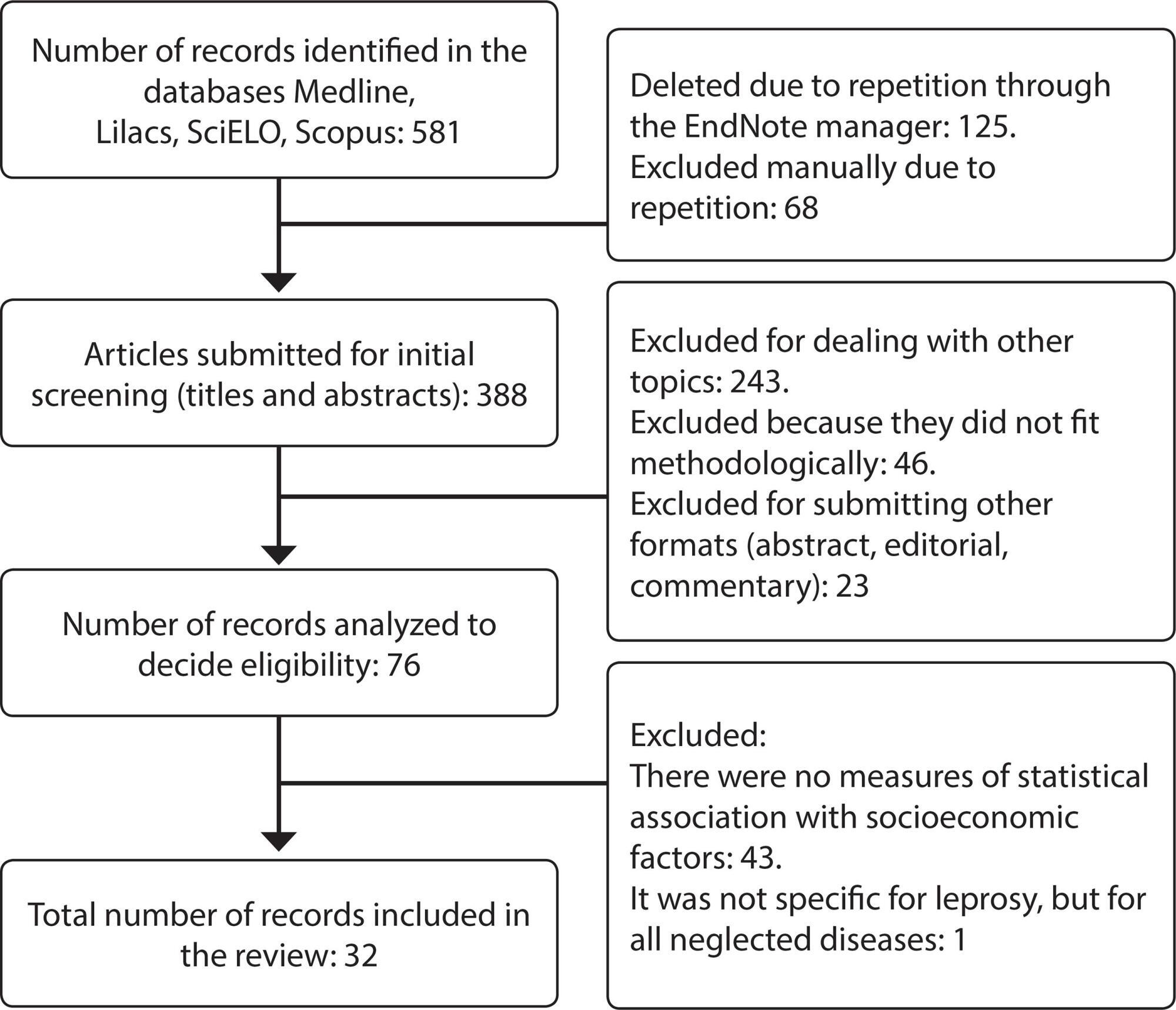
- Heloisy Alves de Medeiros Leano
-
EXPERIENCE REPORT10-26-2020
Brazilian Nursing Process Research Network contributions for assistance in the COVID-19 pandemic
- Alba Lúcia Bottura Leite de Barros
 ,
, - Viviane Martins da Silva
 ,
, - Rosimere Ferreira Santana
 ,
, - Agueda Maria Ruiz Zimmer Cavalcante
 ,
, - Allyne Fortes Vitor
 , [ … ],
, [ … ], - Vinicius Batista Santos

Views0

This is an Open Access article distributed under the terms of the Creative Commons Attribution License, which permits unrestricted use, distribution, and reproduction in any medium, provided the original work is properly cited. Abstract
EXPERIENCE REPORTBrazilian Nursing Process Research Network contributions for assistance in the COVID-19 pandemic
Revista Brasileira de Enfermagem. 2020;73:e20200798
DOI 10.1590/0034-7167-2020-0798
- Alba Lúcia Bottura Leite de Barros
 ,
, - Viviane Martins da Silva
 ,
, - Rosimere Ferreira Santana
 ,
, - Agueda Maria Ruiz Zimmer Cavalcante
 ,
, - Allyne Fortes Vitor
 ,
, - Amália de Fatima Lucena
 ,
, - Anamaria Alves Napoleão
 ,
, - Camila Takao Lopes
 ,
, - Cândida Caniçali Primo
 ,
, - Elenice Valentim Carmona
 ,
, - Erika Christiane Marocco Duran
 ,
, - Howard Karl Butcher
 ,
, - Juliana de Lima Lopes
 ,
, - Leidy Johanna Rueda Díaz
 ,
, - Marcia Regina Cubas
 ,
, - Marcos Antônio Gomes Brandão
 ,
, - Marcos Venícios de Oliveira Lopes
 ,
, - Maria Miriam Lima da Nóbrega
 ,
, - Miriam de Abreu Almeida
 ,
, - Priscilla Alfradique de Souza
 ,
, - Rita de Cassia Gengo e Silva Butcher
 ,
, - Rodrigo Jensen
 ,
, - Rudval Souza da Silva
 ,
, - Sheila Coelho Ramalho Vasconcelos Morais
 ,
, - Tania Couto Machado Chianca
 ,
, - Vinicius Batista Santos

Views0See moreABSTRACT
Objective:
to describe the theoretical construction process of nursing process support documents in COVID-19 care scenarios.
Methods:
an experience report of the joint activity of the Brazilian Nursing Process Research Network (Rede de Pesquisa em Processo de Enfermagem) composed of Higher Education and Health Institution researchers in Brazil.
Results:
five instruments were organized collectively, involving the elements of nursing practice (nursing diagnoses, outcomes and interventions) in assistance for community; for patients (with suspected or mild, moderate, and critical COVID-19 and residents in Nursing Homes); for nursing workers’ health support, also subsidizing registration and documentation during the COVID-19 pandemic.
Final considerations:
valuing the phenomena manifested by families/communities, patients and health professionals is essential for early detection, intervention, and prevention of diseases.


This is an Open Access article distributed under the terms of the Creative Commons Attribution License, which permits unrestricted use, distribution, and reproduction in any medium, provided the original work is properly cited. - Alba Lúcia Bottura Leite de Barros
-
11-13-2020
Fear of childbirth in time of the new coronavirus pandemic
Revista Brasileira de Enfermagem. 2020;73:e20200551
Views0

This is an Open Access article distributed under the terms of the Creative Commons Attribution License, which permits unrestricted use, distribution, and reproduction in any medium, provided the original work is properly cited. Abstract
Fear of childbirth in time of the new coronavirus pandemic
Revista Brasileira de Enfermagem. 2020;73:e20200551
DOI 10.1590/0034-7167-2020-0551
Views0See moreABSTRACT
Objective:
Reflect on how the new coronavirus pandemic triggered or accentuated the fear of childbirth in pregnant women and affected childbirth care practices.
Methods:
Reflective analysis of women’s pregnancy and childbirth experiences during the current pandemic, supported by the latest scientific evidence and recommendations on the topic.
Results:
Pregnancy and childbirth are life-changing events for women, but during the new coronavirus pandemic, fear and uncertainty have taken on an unprecedented dimension in the negative way that many pregnant women have anticipated and experienced childbirth.
Final considerations:
The current period has accentuated a chronic problem: a paternalistic system of health institutions in the approach to childbirth, dense with additional levels of fear in pregnant women. In this context, addressing the fear of childbirth means not giving up the promotion of safe and positive birth experiences for women.


This is an Open Access article distributed under the terms of the Creative Commons Attribution License, which permits unrestricted use, distribution, and reproduction in any medium, provided the original work is properly cited. 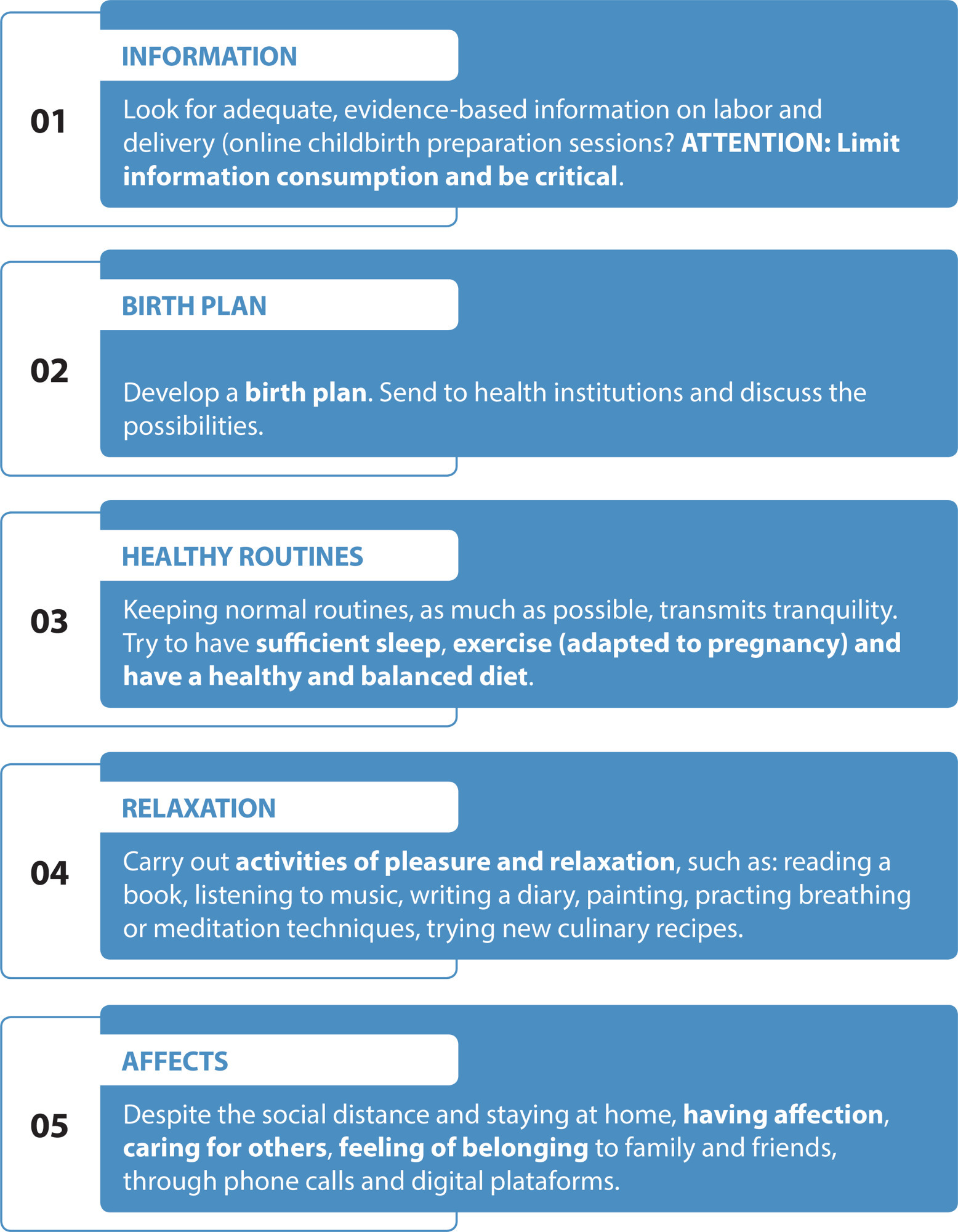
-
01-29-2021
Domestic violence against women amidst the pandemic: coping strategies disseminated by digital media
- Lucimara Fabiana Fornari
 ,
, - Rafaela Gessner Lourenço
 ,
, - Rebeca Nunes Guedes de Oliveira
 ,
, - Danyelle Leonette Araújo dos Santos
 ,
, - Mariana Sbeghen Menegatti
 , [ … ],
, [ … ], - Rosa Maria Godoy Serpa da Fonseca

Views0

This is an Open Access article distributed under the terms of the Creative Commons Attribution License, which permits unrestricted use, distribution, and reproduction in any medium, provided the original work is properly cited. Abstract
Domestic violence against women amidst the pandemic: coping strategies disseminated by digital media
Revista Brasileira de Enfermagem. 2021;74:e20200631
DOI 10.1590/0034-7167-2020-0631
- Lucimara Fabiana Fornari
 ,
, - Rafaela Gessner Lourenço
 ,
, - Rebeca Nunes Guedes de Oliveira
 ,
, - Danyelle Leonette Araújo dos Santos
 ,
, - Mariana Sbeghen Menegatti
 ,
, - Rosa Maria Godoy Serpa da Fonseca

Views0See moreABSTRACT
Objective:
to know the strategies to cope with domestic violence against women disseminated by digital media at the beginning of the COVID-19 pandemic.
Methods:
a documentary study with a qualitative approach. The search took place from March 11 to April 30, 2020, from four sources: newspapers and online portals, social network, official government pages and third sector portals. Thematic content analysis of the findings was performed.
Results:
seventy-seven strategies were identified in the journalistic press, 93 in the social network, 45 in government portals and 40 in third sector organizations. From analysis, three empirical categories emerged: Strategies for communication with women; Strategies adopted by customer service; Strategies to inform the population.
Final considerations:
most of strategies were adaptations of existing services, centered on the reporting of violence by women


This is an Open Access article distributed under the terms of the Creative Commons Attribution License, which permits unrestricted use, distribution, and reproduction in any medium, provided the original work is properly cited. 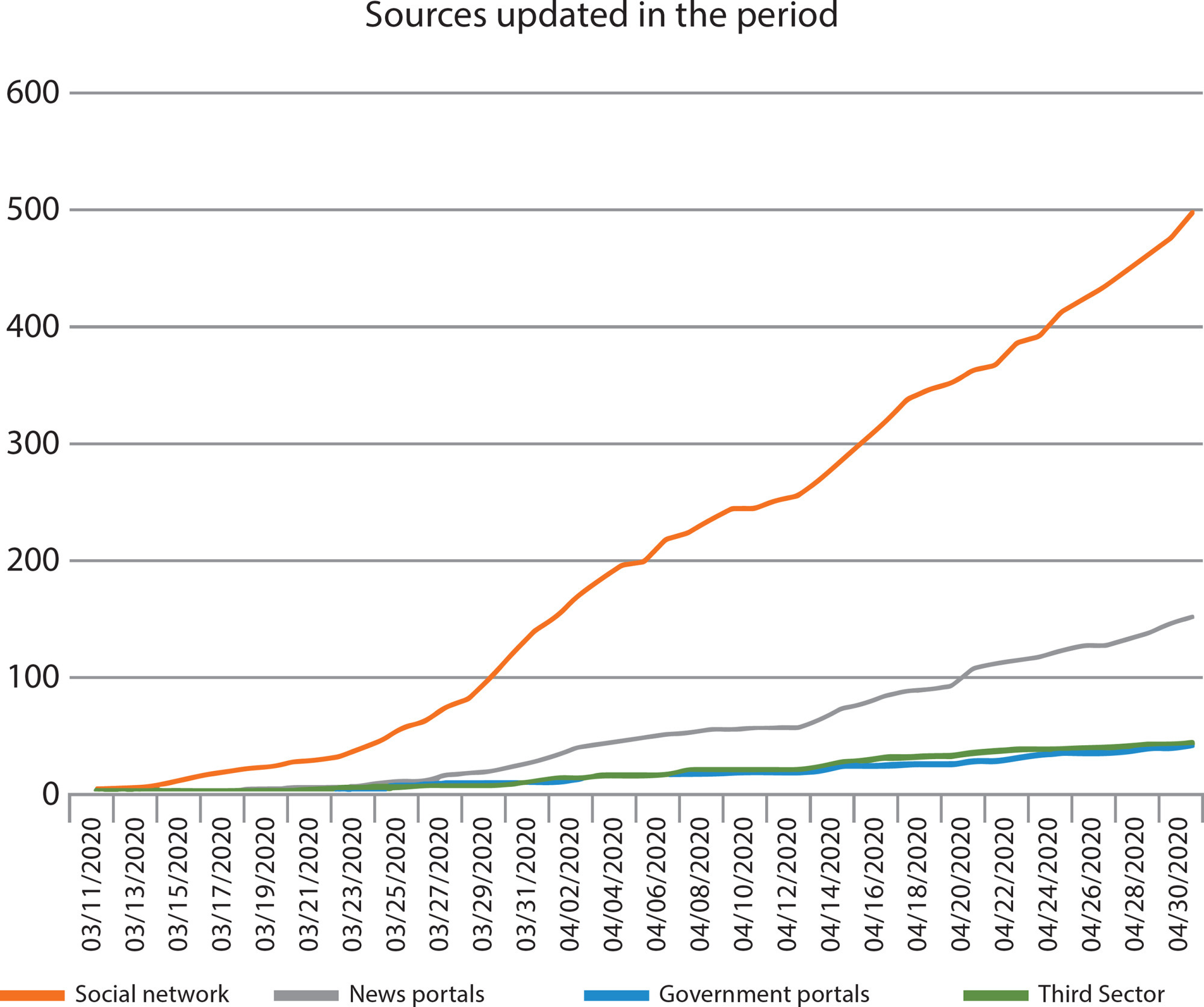
- Lucimara Fabiana Fornari
-
ORIGINAL ARTICLE03-07-2022
Is social isolation during the COVID-19 pandemic a risk factor for depression?
- Adaene Alves Machado de Moura
 ,
, - Igor Roberto Bassoli
 ,
, - Belisa Vieira da Silveira
 ,
, - Alessandra Diehl
 ,
, - Manoel Antônio dos Santos
 , [ … ],
, [ … ], - Sandra Cristina Pillon

Views0

This is an Open Access article distributed under the terms of the Creative Commons Attribution License, which permits unrestricted use, distribution, and reproduction in any medium, provided the original work is properly cited. Abstract
ORIGINAL ARTICLEIs social isolation during the COVID-19 pandemic a risk factor for depression?
Revista Brasileira de Enfermagem. 2022;75:e20210594
DOI 10.1590/0034-7167-2021-0594
- Adaene Alves Machado de Moura
 ,
, - Igor Roberto Bassoli
 ,
, - Belisa Vieira da Silveira
 ,
, - Alessandra Diehl
 ,
, - Manoel Antônio dos Santos
 ,
, - Ronildo Alves dos Santos
 ,
, - Christopher Wagstaff
 ,
, - Sandra Cristina Pillon

Views0See moreABSTRACT
Objective:
To assess factors associated with depression among higher education students and professionals during the peak of the COVID-19 pandemic.
Method:
quantitative study with a cross-sectional design. 550 students and professionals participated. The data were collected by means of a digital questionnaire that included Patient Health Questionnaire-9 to assess depressive symptoms.
Results:
The factors related to depression and social isolation outcomes were significantly associated with the female gender (n= 149; 37,8%; Odds Ratio OR=2,0), white (n=127; 37,2%; OR=1,60), young people (n=130; 39,4%; OR=2,0), without religion (n=70; 40,2%; OR=1,64), with financial problems (n=80; 53,0%; OR=2,40) and family problems (n=98; 47,3%; OR=1,77); who suffered violence during the quarantine (n=28; 58,3%; OR=2,33), increased the use of illicit drugs (n=16; 59,3%; OR=2,69), used sedatives without a medical prescription (n=75; 54,0%; OR=2,94), lived in conflicting relationships (n=33; 54,1%;OR=2,14), lost their job during the pandemic (n=32; 59,3%; OR=1,99) and presented symptoms of anxiety related to COVID-19 (n=155; 45,2%; OR=3,91).
Conclusion:
there is a meaningful relationship between vulnerability and adopting risk behaviors during the pandemic-imposed social isolation with depressive symptoms. We suggest that health professionals be attentive to the need to adjust their psychosocial interventions when promoting strategies when promoting strategies to mitigate the effects and risks to mental health.


This is an Open Access article distributed under the terms of the Creative Commons Attribution License, which permits unrestricted use, distribution, and reproduction in any medium, provided the original work is properly cited. - Adaene Alves Machado de Moura
-
ORIGINAL ARTICLE07-08-2020
Development and validation a nursing care protocol with educational interventions for family caregivers of elderly people after stroke
- Naiana Oliveira dos Santos
 ,
, - Mariane Lurdes Predebon
 ,
, - Carla Cristiane Becker Kottwitz Bierhals
 ,
, - Carolina Baltar Day
 ,
, - Diani de Oliveira Machado
 , [ … ],
, [ … ], - Lisiane Manganelli Girardi Paskulin

Views0

This is an Open Access article distributed under the terms of the Creative Commons Attribution License, which permits unrestricted use, distribution, and reproduction in any medium, provided the original work is properly cited. Abstract
ORIGINAL ARTICLEDevelopment and validation a nursing care protocol with educational interventions for family caregivers of elderly people after stroke
Revista Brasileira de Enfermagem. 2020;73:e20180894
DOI 10.1590/0034-7167-2018-0894
- Naiana Oliveira dos Santos
 ,
, - Mariane Lurdes Predebon
 ,
, - Carla Cristiane Becker Kottwitz Bierhals
 ,
, - Carolina Baltar Day
 ,
, - Diani de Oliveira Machado
 ,
, - Lisiane Manganelli Girardi Paskulin

Views0See moreABSTRACT
Objective:
development and validation the content of a nursing care protocol with educational interventions for family caregivers of elderly people after stroke.
Methods:
a methodological study conducted in three stages: (1) protocol development through literature review; (2) pretest with multidisciplinary team, analyzed with literature articulation; (3) protocol validation by the Delphi Technique.
Results:
the protocol was structured in the following areas: Disease Guidelines; Emotional Support; Using the Health Care Network; Diet; Airways; Medications; Hygiene; Skin Care; Disposal; Dressing/Undressing; Positioning and Transfer; Fall Prevention. In the pretest, eight experts assessed protocol clarity and content. In validation, there were two rounds by the Delphi Technique. The validated protocol consisted of 12 domains, containing 42 items and 240 care guidelines.
Conclusion:
the protocol qualifies the transition of care after hospital discharge assisting nurses in home care practice.


This is an Open Access article distributed under the terms of the Creative Commons Attribution License, which permits unrestricted use, distribution, and reproduction in any medium, provided the original work is properly cited. 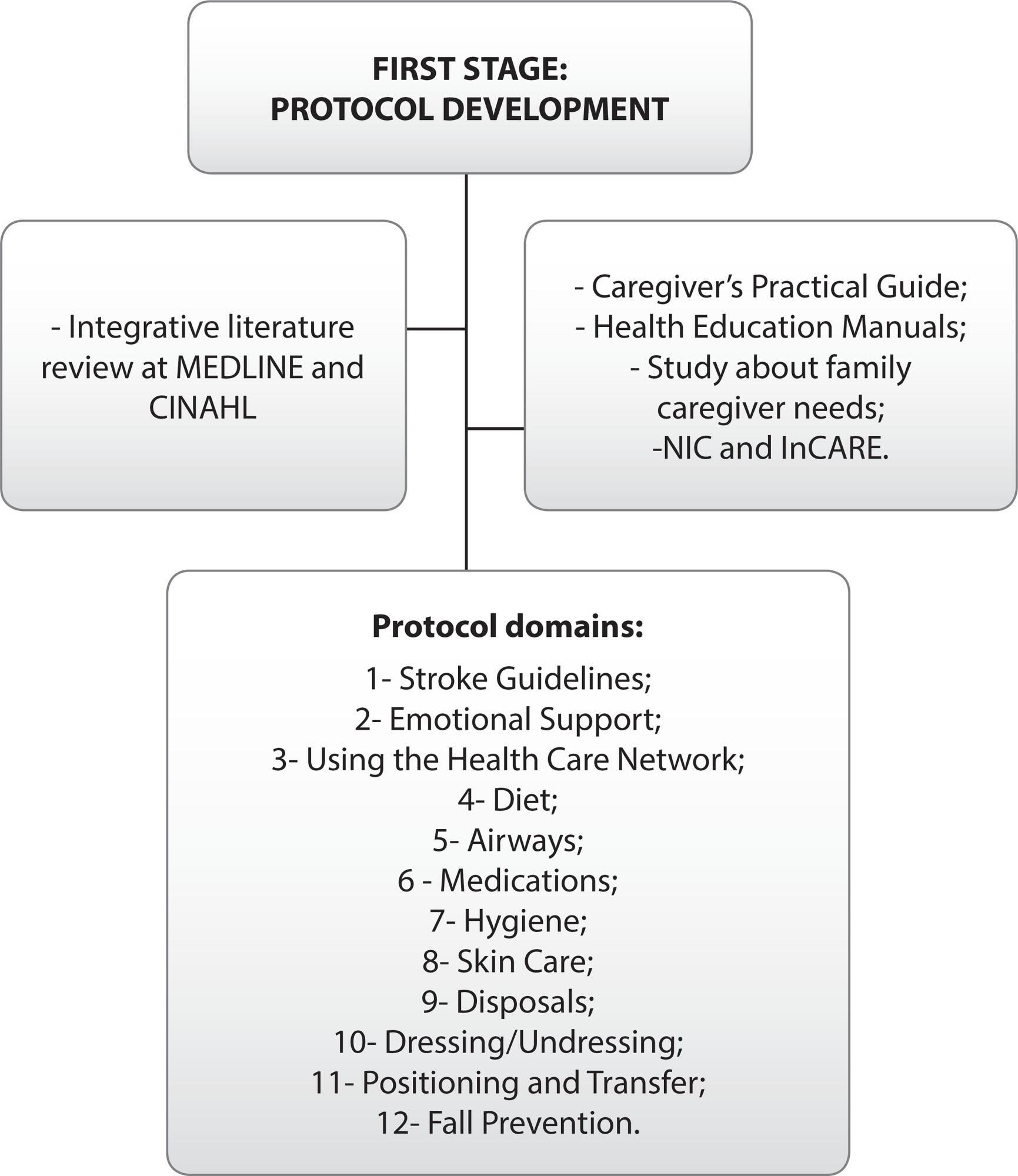
- Naiana Oliveira dos Santos
-
REVIEW04-22-2020
Polycyclic aromatic hydrocarbons and development of respiratory and cardiovascular diseases in workers
- Helenize Ferreira Lima Leachi
 ,
, - Maria Helena Palucci Marziale
 ,
, - Júlia Trevisan Martins
 ,
, - Patricia Aroni
 ,
, - Maria José Quina Galdino
 , [ … ],
, [ … ], - Renata Perfeito Ribeiro

Views0

This is an Open Access article distributed under the terms of the Creative Commons Attribution License, which permits unrestricted use, distribution, and reproduction in any medium, provided the original work is properly cited. Abstract
REVIEWPolycyclic aromatic hydrocarbons and development of respiratory and cardiovascular diseases in workers
Revista Brasileira de Enfermagem. 2020;73(3):e20180965
DOI 10.1590/0034-7167-2018-0965
- Helenize Ferreira Lima Leachi
 ,
, - Maria Helena Palucci Marziale
 ,
, - Júlia Trevisan Martins
 ,
, - Patricia Aroni
 ,
, - Maria José Quina Galdino
 ,
, - Renata Perfeito Ribeiro

Views0See moreABSTRACT
Objectives:
to identify the scientific evidence on the development of cardiovascular and respiratory diseases due to workplace contamination by polycyclic aromatic hydrocarbons.
Methods:
integrative literature review. The search for primary articles was held in October 2017 in the Medical Literature Analysis and Retrieval System Online (through Pubmed), Web of Science and Latin American and Caribbean Literature in Health Sciences (LILACS).
Results:
the 16 studies analyzed showed that exposure to polycyclic aromatic hydrocarbons was associated with cardiovascular diseases, such as increased blood pressure, heart rate variation, and ischemic heart disease; and respiratory disorders, such as decreased lung function, chronic obstructive pulmonary disease, asthma, wheeze, coughing, pulmonary wheezing, chest tightness, effort dyspnea, and sore throat.
Conclusions:
polycyclic aromatic hydrocarbons cause deleterious effects on the cardiovascular and respiratory systems through mutations and cellular inflammation, being a risk to exposed individuals.


This is an Open Access article distributed under the terms of the Creative Commons Attribution License, which permits unrestricted use, distribution, and reproduction in any medium, provided the original work is properly cited. 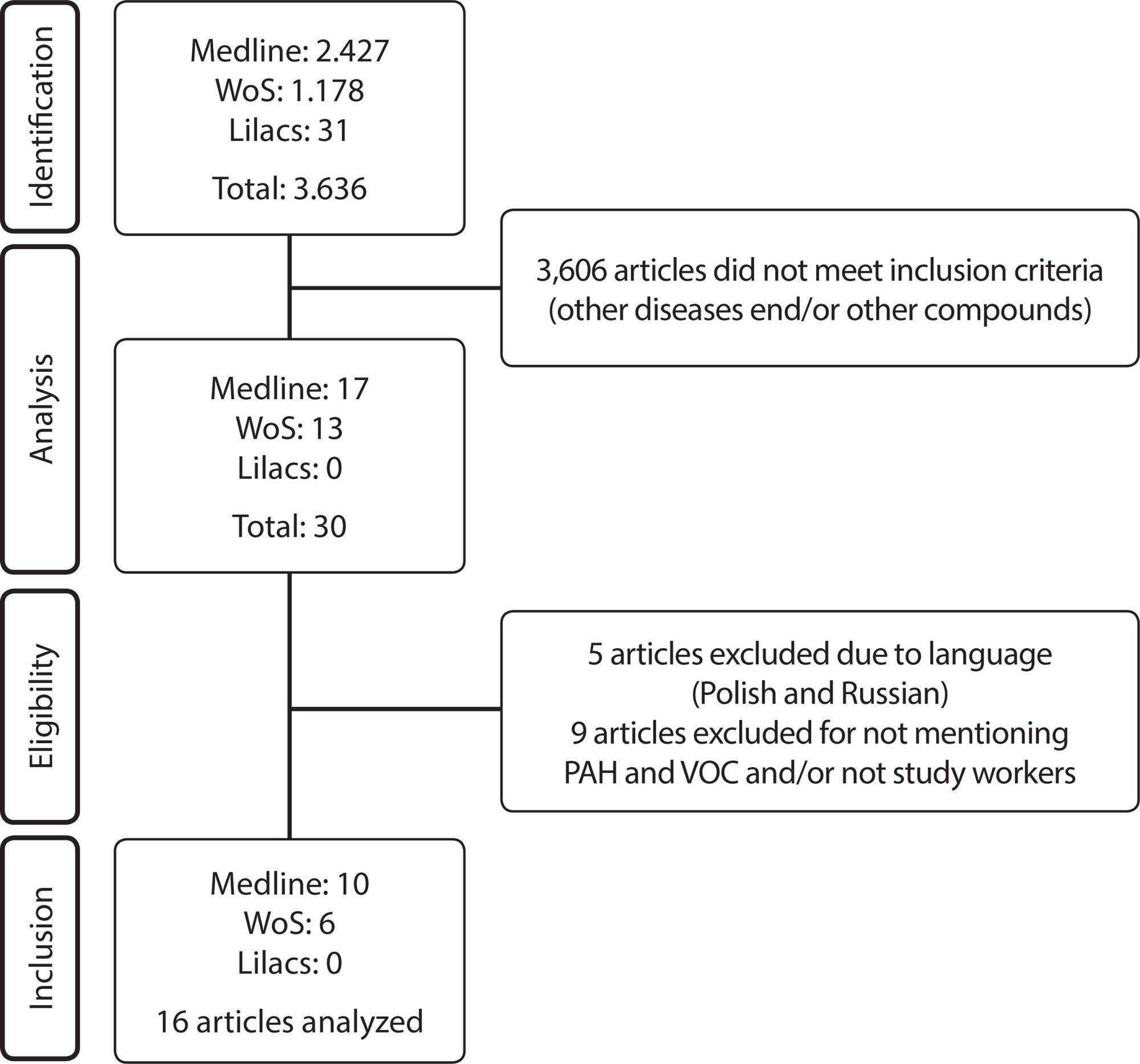
- Helenize Ferreira Lima Leachi
Search
Search in:
Nuvem de Tags
Enfermagem (930)Cuidados de Enfermagem (269)Atenção Primária à Saúde (239)Idoso (208)Educação em Enfermagem (151)Segurança do Paciente (150)Saúde Mental (145)Educação em Saúde (139)Estudos de Validação (131)Qualidade de Vida (104)Tecnologia Educacional (100)Promoção da Saúde (99)COVID-19 (91)Criança (91)Família (87)Enfermagem Pediátrica (86)Saúde do Trabalhador (86)Adolescente (85)Saúde Pública (82)Estudantes de Enfermagem (77)

